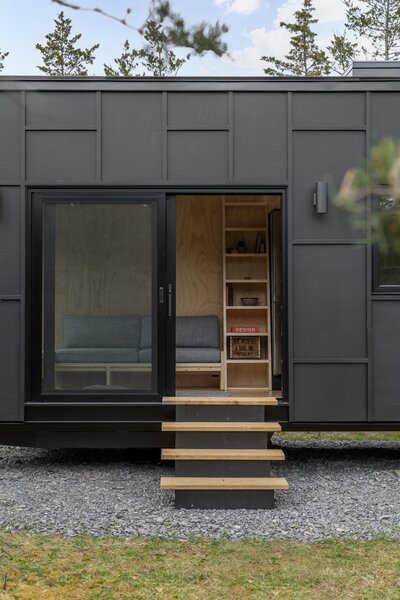Payam Shalchian and Lee Loewen created three wood-clad models starting at 260 square feet that are meant to provide a path to homeownership in Ontario’s tough housing market.
Welcome to Tiny Home Profiles, an interview series with people pushing the limits of living small. From space-saving hacks to flexible floor plans, here’s what they say makes for the best tiny homes on the planet. Know of a builder we should talk to? Reach out.
Payam Shalchian and Lee Loewen knew neither of them could afford a traditional home, but that didn’t make them feel stuck. "We’re both industrial designers, and we thought, There has to be a better way," Shalchian remembers. So in 2020, they banded together and founded Instead, a tiny home company that now has three models that are meant to be more affordable than the single-family residences in their native Ontario: the P01; its all-electric counterpart, the P02; and the L01, which is designed to rest on a foundation.
"Lee and his family lived in the P01 for two-and-a-half years, which provided many firsthand insights to improve our design," Shalchian says. Read on to learn more about Canadian tiny home company Instead, and how it’s endeavoring to provide an alternative path to owning a home.

The company’s first offering, P01, is set on wheels and classified as an RV in Canada.
Photo courtesy of Instead
What qualities make your tiny home stand apart from the rest?
We pay a lot of attention to the "performance" of the house. Within the context of affordability, a house can be expensive to operate and maintain over its lifespan. So, we encourage our clients to prioritize spending on what makes their house perform better and last longer.
We tend to incorporate high-performance building materials as well as techniques and practices to ensure that our clients have a healthy home that would last for many years and need very little upkeep. And although we have a systems-first approach, we apply this thinking to the finishes, too. This is where some of the customization work comes in, to make the house reflective of a client’s taste.

The homes are turnkey, but clients can request customization.
Photo: Jean Bai Photo
What’s the most exciting project you’ve realized to date?
Our L01 unit is the most exciting project. It is our first home intended for a permanent foundation, which makes it more applicable to the context of a walkable city. Here in Ontario, tiny homes on wheels—or "mobile" tiny homes—still face great limitations to become a viable housing option due to zoning bylaw implications. This is the case in many cities. However, tiny homes can be placed or built on a foundation and be used as an additional or a secondary dwelling unit, and that’s the opportunity L01 presents.

See the full story on Dwell.com: Two Canadian Designers Couldn’t Afford a Home, So They Built Some Really Nice Tiny Ones
Related stories:
- Camping Turned Into Glamping After a Family Built Twin Tiny Cabins in the Woods
- The Add-Ons Are Seemingly Endless With Modern Tiny Living’s $85K Tiny Homes
- A San Antonio Property Is More About the Drought-Resistant Yard Than the Tiny Home It Surrounds
Read More
By: Kelly Dawson
Title: Two Canadian Designers Couldn’t Afford a Home, So They Built Some Really Nice Tiny Ones
Sourced From: www.dwell.com/article/instead-tiny-homes-custom-designed-millwork-460ebd49
Published Date: Wed, 22 May 2024 17:00:44 GMT
.png)





